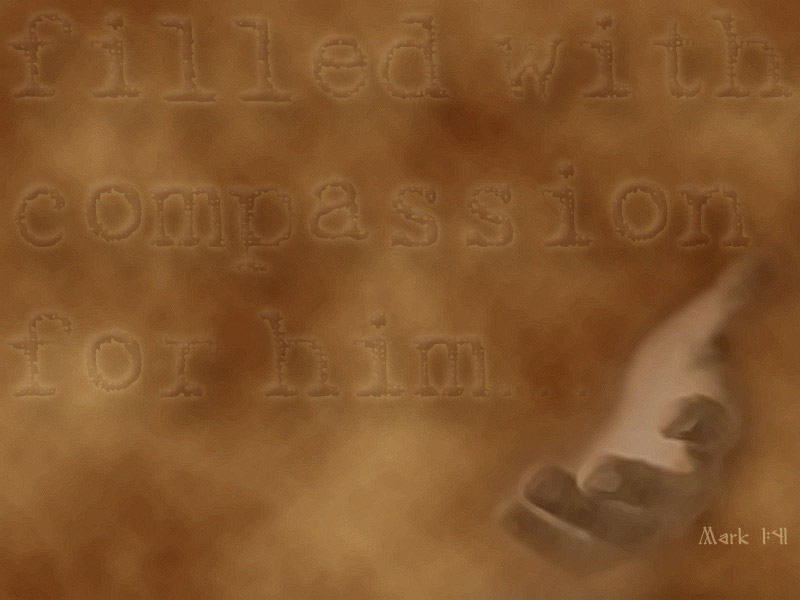We don't notice it.
We can't imagine it.
We so easily forget it.
What's the "it"?
The "it" is that Jesus not only came to show us how God would live among us, but that he also showed us how to fully live as mere mortals. Unfortunately, we don't usually notice how Jesus dealt with people to see how we should. We can't imagine that Jesus' actions should be our actions. We so easily forget that the truths Jesus taught and the way Jesus lived his life are not just for our ultimate salvation, but also examples for our daily interactions.
God profoundly reminded me of this "it" as I was talking about life skills with a young Chinese Christian woman. I used the story of Jesus healing a man with leprosy as a great example of how Jesus' followers should interact with others:
A man with leprosy came and knelt in front of Jesus, begging to be healed. "If you are willing, you can heal me and make me clean," he said.Moved with compassion, Jesus reached out and touched him. "I am willing," he said. "Be healed!" Instantly the leprosy disappeared, and the man was healed.
Then Jesus sent him on his way with a stern warning: "Don't tell anyone about this. Instead, go to the priest and let him examine you. Take along the offering required in the law of Moses for those who have been healed of leprosy. This will be a public testimony that you have been cleansed" (Mark 1:40-44 NLT).
 Because Jesus uses his power to heal the man, we miss the key way Jesus attends to this man and his needs. We don't see Jesus' actions as a blueprint for the way we should interact with others. Yet as I have struggled with not being fully present with others because of the distractions of my high-tech devices, I have returned to this interaction between Jesus and the man with leprosy again and again to re-tune my own heart.
Because Jesus uses his power to heal the man, we miss the key way Jesus attends to this man and his needs. We don't see Jesus' actions as a blueprint for the way we should interact with others. Yet as I have struggled with not being fully present with others because of the distractions of my high-tech devices, I have returned to this interaction between Jesus and the man with leprosy again and again to re-tune my own heart.
Notice several stages of being fully present that are demonstrated by Jesus in this story.
Jesus sees the man.The man places himself in front of Jesus. Jesus fully sees him and knows his condition. We know this because Jesus moves with compassion to act. He acts in ways that clearly demonstrate he has seen the man, understands his situation, and cares about his needs. How many people do we neglect, miss, or ignore because we are not fully available to truly see them as they are?
Jesus hears the man.Notice that Jesus responds verbally to the man with words that show he has heard what the man had said:
"If you are willing you can...""I am willing..."
As a man, and being raised the way I was as a man, I tend to want to fix things for someone even before I fully understand their problem. I don't let them know they have been heard and that their emotions matter. I rush to fix. Jesus reminds me in this story of a different way to proceed. He first validated this man's emotional wounds in two ways. One of those ways is to let the man know he has been heard — that his words matter to Jesus — "I am willing..."!
Jesus touches the man.There are cultural, personal, and gender taboos about touching someone. While we need to be cognizant of these, Jesus' care to touch* people in appropriate ways reminds us that human touch is very important in every kind of human conversation. Touch moves interactions from conversation to genuine contact with another human being. In this story, touch carries an incredible message. Lepers could not receive human touch from anyone, so Jesus' touch BEFORE healing the man is a powerful message to the man — I am willing to be unclean with you and share your burden because you matter to God and to me. In less dramatic conversations, touch is still important because it brings us into physical contact with the person and says, "I am really present for you in this moment."
Jesus acts on the man's request.Jesus speaks healing into the man's life, because as Son of God, he has the power of God to speak and make things happen. While we do not have the same power of Jesus, we have much more authority to act as his presence than we often utilize. Even in more casual conversations, when people make requests of us, it is important to act or react in some clear way to show they are important to us. Even if our actions are to clarify our disagreement with their request or to limit our response to their request in some way, action is important. Too often, simply to preserve the appearance of polite society, we agree or appear to accept another's words, but do nothing. Sometimes this is out of intentional neglect and sometimes out of a passive-aggressive neglect that allows us to look good in the moment while never intending to follow through with any genuine response. (This is the so-called "nice" response, but as followers of Jesus, we need to be reminded we are never commanded to "be nice" — we are to be kind and gentle, but "nice" is never commanded and has become the excuse for all sorts of self-serving behaviors!)
Jesus clarifies his expectations with the man.Jesus tells the man to do what the Law requires. Jesus had the authority to make the demand, but the principle is important in our communications as well. Caring and communicating with someone does not mean we are "taking them on to raise from here to eternity"! Jesus' style of communication means being fully present: to seeing, hearing, touching, and acting based on our interaction with another person. It does not mean volunteering to be co-dependent or complicit in damaging behaviors on the part of others. Clarifying our ongoing response and relationship is important if we are to have a healthy and lasting relationship with anyone. This clarification also sets the stage for our next interaction with the person with whom we are currently sharing the communication.
As you read the gospels that tell the story of Jesus, I encourage you to notice these elements of Jesus' interactions with people in other places that are similar to what we find here:
- He sees the man.
- He makes clear that he hears the man's words and heart.
- He touches the man to break the isolation and create a true connection.
- He acts in response to the man's words and needs.
- He clarifies his ongoing expectations for the relationship with the man.
Now let's think about our life interactions:
- What principles from Jesus' example can we carry with us into our own interactions?
- Where are we strongest?
- Where are we neglectful?
- What is the proper way to respond at each level of the interaction?
Jesus came to give us full and abundant life (John 10:10). Jesus called on us to serve each other as he has served us (John 13:12-17). Jesus sends each of us out into the world to do the work and to live the life that the Father sent him to accomplish (John 20:19-21). Let's follow our Lord's lead as we connect with others in our daily lives!

* The Touch of Jesus in the Gospels:
There are many references to Jesus touching people in the four gospels — Matthew, Mark, Luke, and John. Here are a few examples from Matthew. You can find others with a concordance or online Bible search. The example of Jesus in this way is very powerful, both as he touches or allows people to touch him. (As with all Bible references in our articles, you can click on the verse and a pop up window shows you the verse or takes you to the online resource.)
Matthew 8:3 — man with leprosy
Matthew 8:15 — Peter's mother-in-law
Matthew 9:18 — Synagogue leader wants Jesus to lay hands on his daughter
Matthew 9:20-21 — Woman with the hemorrhage of blood
Matthew 9:25 — Jesus takes the hand of the dead girl
Matthew 9:29 — touching the eyes of the blind men
Matthew 14:36 — the sick wanting to touch Jesus' robe
Matthew 17:7 — Jesus touches the inner three during his transfiguration
Matthew 19:13-15 — parents bring their young children for Jesus to lay his hands on them
Matthew 20:34 — Jesus touches the eyes of blind men
Especially powerful are the instances after the resurrection where touch was important (Matthew 28:8-10 and John 20:11-28).










Reader Comments
Archived Facebook Comments